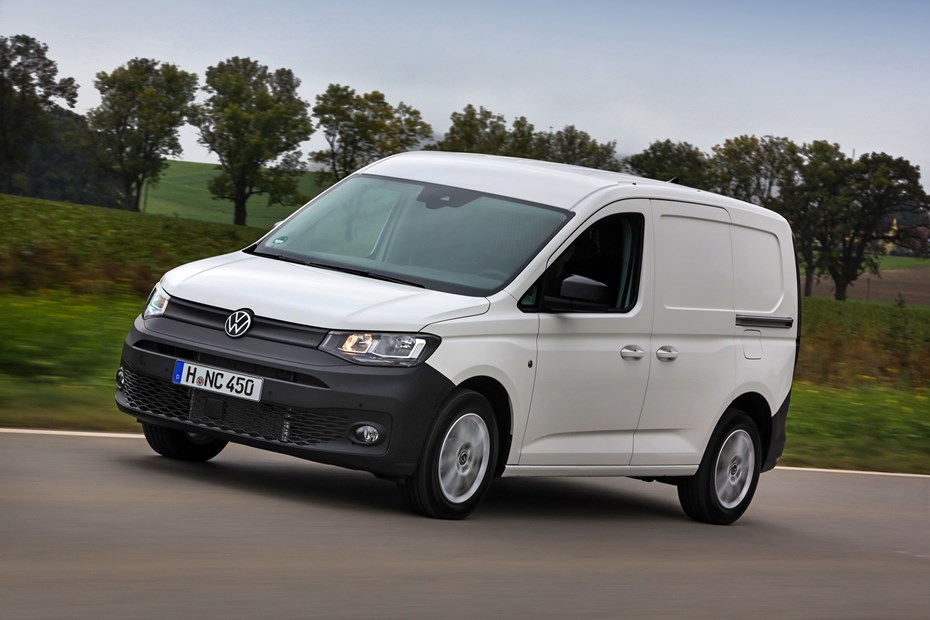UPDATE: we have now driven this new van – read our full VW Caddy Cargo review.
The all-new VW Caddy van will be called the Volkswagen Caddy Cargo when it goes on sale in the UK in December 2020. Set to reach its first customers in earlier 2021, the fifth-generation Caddy – or Caddy 5 – will be priced from £17,800, come in two body sizes and three trim levels, and offer 4Motion four-wheel drive.
The VW Caddy Cargo name will be used to distinguish the panel van from the passenger carrying versions, which will now go by plain Caddy instead of Caddy Life (Life becomes a trim level for these instead). Whether it seats two people or a whole family, the new van is packed with technology and already meets the 2021 Euro 6 emissions standards.
>> Sign-up for the Parkers Vans and Pickups newsletter
How new is all-new?
For the first time, the 2021 Caddy Cargo sees Volkswagen’s highly versatile MQB car platform used as the basis for a van. MQB can be found beneath everything in the VW Group line-up from the Volkswagen Golf to the Skoda Kodiaq SUV – and even the Audi TT sportscar – which means it brings a great deal of modernity and technology to the Caddy for the first time.
One of the key things about it, says VW, is that it will make the Caddy more comfortable as well as more sophisticated to drive.
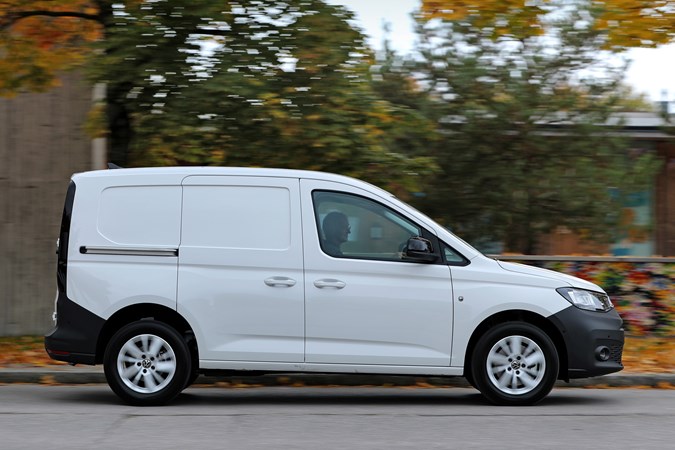
The new McPherson strut front suspension design allows a higher steering ratio – so you have to turn the wheel with less effort to achieve greater steering angle, making manoeuvring easier – while the rear suspension features coil springs instead of old-fashioned leaf springs among other changes to make that completely new as well.
This rear suspension set-up is also more compact, allowing for wider loads in the rear (a Euro pallet will now fit sideways, for example). Together with a new rear axle design this should help the Caddy remain comfortable and ‘agile’ no matter how it is loaded.
What about the engines?
These are also new; UK Caddy Cargo buyers get a choice three 2.0-litre TDI diesel options and a 1.5-litre TSI petrol.
The turbodiesels come with 75hp, 102hp or 122hp, and use a new ‘twin dosing’ AdBlue system which delivers a double-shot of the exhaust cleaning juice, reducing emissions (especially NOx emissions) ‘significantly’ compared with the previous Caddy.
The turbo petrol provides 114hp and features Active Cylinder Technology (ACT), which means it cut shut down two cylinders when demand is low to save fuel.
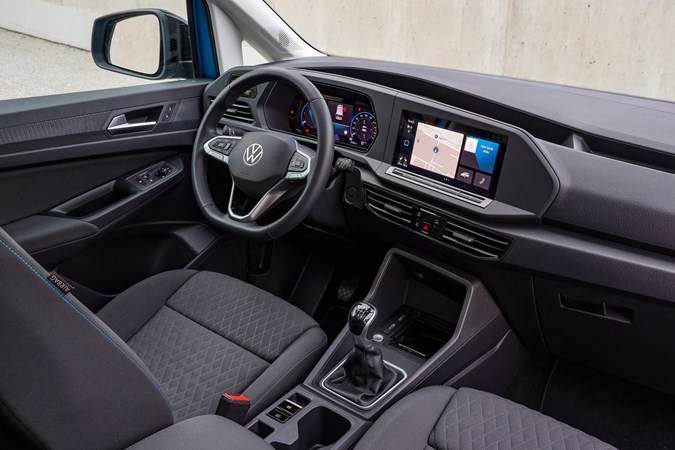
All models come with a six-speed manual gearbox as standard, with a seven-speed DSG automatic optional on the 122hp diesel and 114hp petrol.
The 122hp diesel will also be available to order with 4Motion four-wheel drive – though if you fancy this don’t hang about, as we suspect it may not last long on the UK pricelist. The standard Caddy 5 range is front-wheel drive, just like its predecessor.
How many versions of the 2021 Caddy are there?
As before there are two versions – the standard-length Caddy and the long-wheelbase (LWB) Caddy Maxi. As we’ve already mentioned, the vans will now be called Caddy Cargo, while the passenger carriers will be known as the Caddy.
The standard-length model is 4,500mm long (93mm longer than before) with a 2,755mm wheelbase (73mm longer). The LWB Caddy Maxi is 4,853mm long (actually 25mm shorter than before) with a 2,970mm wheelbase (36mm shorter). Both are 1,855mm wide excluding the door mirrors (an increase in the body of 62mm) and 1,812mm high (11-24mm lower).
The Caddy Cargo van will be sold in three trim levels, but Volkswagen hasn’t announced what these will be called yet.
What’s the load space like?
Swings and roundabouts here, as the standard version is slightly more practical in the back than it was, while the larger Caddy Maxi is quite a bit shorter.
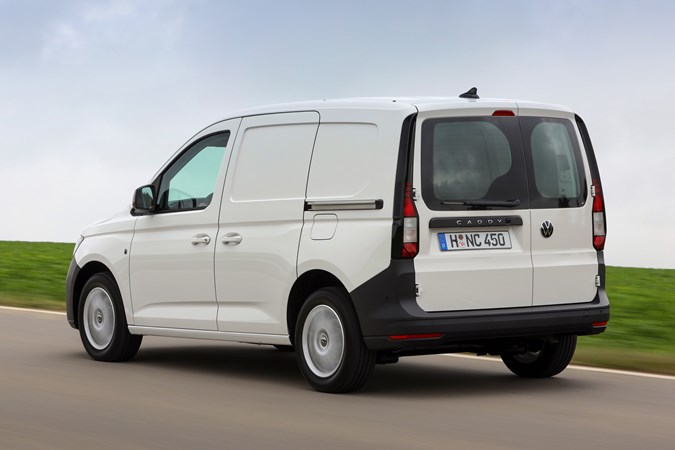
Both benefit from that new rear suspension and extra width, making the load space wide enough to load a Euro pallet sideways now. Load area length has also increased for the standard Caddy Cargo, and load area height has gone up for both versions, despite the roof being lower.
Caddy Maxi sees its maximum load area length fall from 2,249mm to 2,150mm. However this is still enough for two Euro pallets.
Load volume for the Caddy Cargo is 3.1 cubic metres, and for the Caddy Maxi Cargo (or Caddy Cargo Maxi, whichever it is) load volume is 3.7 cubic metres.
What about the Caddy Cargo’s payload?
The only payload info we have so far is that the Caddy Cargo can carry up to 780kg.
Details of the Caddy Maxi van are still to be confirmed. Hopefully it will do better than that, or it will leave the new Caddy a long way behind the best in the small van sector, which are all at around 1.0-tonne (1,000kg) or more now.
Any changes in the cabin?
Completely new and much more car-like inside the cab, the 2021 Caddy also comes with loads more technology.
The standard-fit touchscreen infotainment system in the centre has screen sizes from 6.5 to 10.0 inches, while a digital instrument cluster will be an option on some versions. More impressively, there are 19 driver assistance systems available, including six that are brand new to the Caddy.
For instance, new Travel Assist offers ‘assisted driving’ at all speeds (meaning it will keep you in lane and actively monitor the distance to the vehicle in front, even under cruise control).
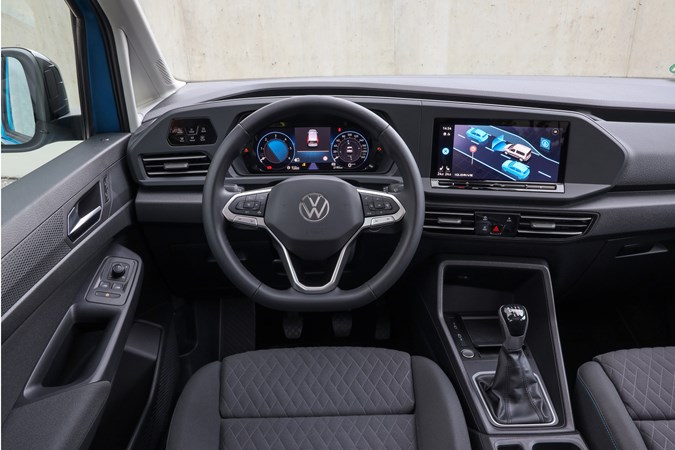
At the same time, the multi-function steering wheel comes with built-in ‘capacitive sensors’ in an effort to stop the system asking you to put your hands back on the wheel when you’re already holding it (a problem that plagues the latest VW Transporter 6.1 and several VW Group car models).
Perhaps of more use to more van buyers is the option of Trailer Assist on the Caddy for the first time, which makes reversing with a trailer much, much easier.
A built-in eSIM on every new Caddy means it can automatically call the emergency services in the event of an accident. This also enables a whole bunch of connectivity features, allowing you to access info about the van from the comfort of your smartphone.
You’ll also an electronic handbrake with auto-hold function in the cabin for the first time, plus new touch-sensitive switches for the lights – which is probably going to divide opinion. We’re not overly impressed with this ‘innovation’ in VW’s car range, there wasn’t really anything wrong with the old dial design.
Any other 2021 Caddy pricing information?
Yes. Although VW has announced the trim levels, it has revealed a few key price points for the new Caddy (all on-the-road but excluding VAT).
The entry-level £17,800 gets you behind the wheel of a 114hp TSI petrol Caddy Cargo in the standard size. Electric windows, electronic handbrake, multi-function steering wheel, height-adjustable driver’s seat and a 6.5-inch touchscreen infotainment system.
‘Mid-level’ models will start from £19,275, and include air-conditioning, body-coloured bumpers, rear-parking sensors and power-adjustable lumber support for the driver. Plus leather trim for the steering wheel.
Top spec versions will start at £21,475, and include Discover Media satellite-navigation, automatic lights and wipers, auto-dimming rear-view mirror, and alloy wheels. The very top of the range 122hp TDI with 4Motion four-wheel drive is priced £26,850.
UK orderbooks open December 2020, with first deliveries expected towards the end of quarter one (Q1) in 2021 – which likely means March.
Anything else we should know?
Two things.
Firstly, look out for our brand new VW Caddy Cargo review very shortly – as in within the next couple of weeks.
Secondly, the new Caddy will also form the basis of Ford’s next small van – presumably still to be called the Transit Connect – as one of the first fruits of the Ford-VW global alliance, which will see the two firms sharing development and production of their next-generation van and pickup ranges.
Also read:
>> Our current Volkswagen Caddy review
>> The best small vans you can buy now
>> Next Ford small van to be based on new VW Caddy
Just so you know, we may receive a commission or other compensation from the links on this website - read why you should trust us.


